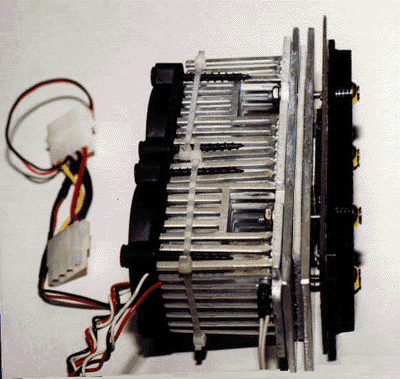
 |
Once Rain kicked in, the processor temperature dropped quickly, though not as quickly as in the first attempt. This is due to the "cold plate" having heated up during the boot process and the peltier needing time to remove the heat from both the plate and the processor. After some full WinBench99 suites and a few Quake2 timedemos and I was convinced that it was time to try for 504 again.
At 504 and 2.6 volts, I finally was able to run back to back WinBench suites after running a few timedemos without a lock-up. I backed the voltage down to 2.5 and much to my surprise, it was still not locking up. I think that this was the point when I started to get a little excited! It finally looked like I might be able to run this Celeron at 504.
Attempt 3
I had noticed that the peak temperature
of the processor was still a little higher than I was comfortable with.
I began to go back over the design and realized that I had left out one
important component in my heat sink prototype. There was no insulation
between the hot heat sink and the cold plate. Heat from the sink
was being radiated back to the cold plate. I had read about this
at Tellurex's site and it had slipped my mind. Out came the peltier
sandwich again. I decided on using closed-cell foam insulation and
after testing a couple of samples to see how high of temperatures they
could handle, I settled on cutting up a foam tray that meat from the grocery
store comes packed on. I'm sure that some searching would have produced
something a little more esoteric, but this stuff insulates well and survived at
temperatures over 150°F without any signs of deforming or melting.


|
|
Intro . |
voltage limits |
high volts |
trying peltiers |
second attempt |
stable @ 504 |
lower voltage |
case heat |
final thoughts |
build it |